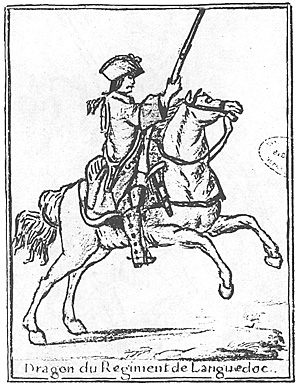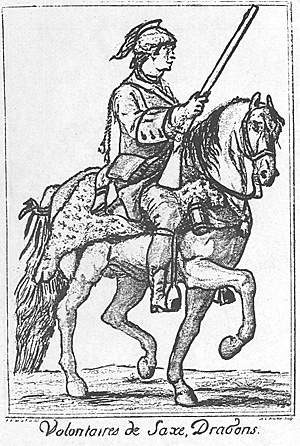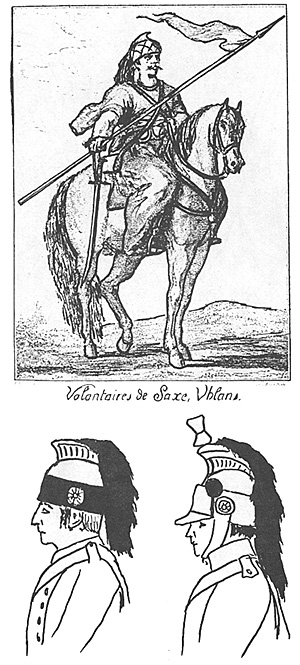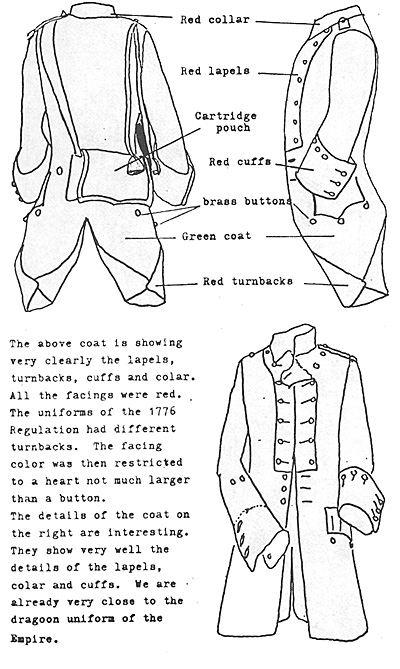French Light Troops Part I
French Light Troops Part II
French Light Troops Part III
 Les Volontaires de Saxe are certainly the light unit with the most prestigeous reputation in the French Army. They were the result of an experiment. Arminius Maurice, comte de Saxe, marechal de France in 1744, was the son of Frederic-August, elector of Saxe, who became King of Poland under the name of August the II, and of Aurora of Konigsmark.
Les Volontaires de Saxe are certainly the light unit with the most prestigeous reputation in the French Army. They were the result of an experiment. Arminius Maurice, comte de Saxe, marechal de France in 1744, was the son of Frederic-August, elector of Saxe, who became King of Poland under the name of August the II, and of Aurora of Konigsmark.
The uniform is typical of the French dragoons from 1700 to 1755. Please note the hat etc. Compare with the other pictures showing a dragoon and a uhlan of the Volontaires de Saxe. The coat of the above dragoon from the regiment de Languedoc is blue with red cuffs. There are no other facing color than the cuffs. The dragoon of the Volontaires de Saxe has already all the facings red, lapels, cuffs, collar and turnbacks.
Pictures from the French Ministere de la Guerre Parocel AIJ 7.
The comte de Saxe entered the French Service in 1720, after a campaign against the Turks under Eugen. He was elected Duke of Courlande in 1726, but he could not held the charge against the will of Russia. He resigned officially is Dukedom in 1728 to emigrate in France. He had with him a troop of his Polish and Coulandese (Lithuanians) with him. He had many new ideas in his head on the organization of troops. He dreamed to put them to practice. In March 1743, the King of France allow him to raise a cavalry unit of some 1000 men to be commanded by him under the name of VOLONTAIRES DE SAXE.
The organization of that new unit is different from the French traditional organization of that period. The new unit is divided in six brigades of two companies each: one of lancers or uhlans and the other of "pacolets" or dragoons. In theory, the lancers are poles or Lithuanians or also German. The lancers should be noblemen. The dragoons are French and commoners. The 1st brigade is called the white brigade, and is mostly including negroes or orientals. The recruitment of Polish noblemen was not easy in France and even before the death of de Saxe in 1750, most of the Polish uhlans had disappaered.
The Volontaires de Saxe were the personal guards of the Marshall de Saxe (already some form of Guides. They were involved in most of the battles especially in the ones at which de Saxe was present such as Fontenoy, Raucoux, Lawfeld etc. They were with de Saxe in Souabe in 1743 and 1744 then in Flanders etc.
 The pictures show very clearly the helmet of the Volontaires de Sake. Dragoons and Uhlans had almost the same helmet. Compare the two pictures with the picture at the top of this article showing a dragoon of the regiment de Langedoc, which is wearing a typical French dragoon uniform. The difference in style is easy to see.
The pictures show very clearly the helmet of the Volontaires de Sake. Dragoons and Uhlans had almost the same helmet. Compare the two pictures with the picture at the top of this article showing a dragoon of the regiment de Langedoc, which is wearing a typical French dragoon uniform. The difference in style is easy to see.
Initially the Volontaires de Saxe were stationed in Vendome then in Chambord with the Marshall. After the death of the Marshall in 1750, the Volontaires de Saxe were only 360. They did not include anymore color people or uhlans. The unit was transferred to the command of the comte de Friezen. He had a great deal of experience with light troops. De Friezze was the acting commander of the Volontaires de Frienzen until then.
The Volontaires de Saxe in 1755 take the name of their new commander the comte de Shoenberg. They become Volontaires de Schonberg. In 1761 the unit is increased of the two companies and become Dragons de Shoenberg under which name they were to serve until the French Revolution. During the Seven Years War, the Volontaires de Shoenberg were at Haastembeck, Creffeld, Bergen, Munden, Corbach, Warbourg, Willinhausen, Grebenstein and Johannisberg.
I should have said above, that, after the Peace of Aix-la-Chapelle, the King of France, impressed by their performances during the war, called to Versailles to meet them and review them. The Parisians were also very impressed and the Volontaires de Saxe made a triumphant entry in Paris.
So much for the history of the Volontaires de Saxe. So far nothing is very unusual after what we saw in issue 23 of this magazine. Well you are right, but the impact of the uniform of the dragoons is significant and was going to influence the dragoons uniforms in the French Army for a very long time.
Until the Dragoons of the Volontaires de Saxe, the color of the French dragoons coats (called justaucorps) were anything but green. The dragoons of the Regiment de Rochepierre and of the Regiment de Languedoc were red and blue respectively. The color of the coat of the dragoons of the Volontaires de Saxe was green. It took until 1762 to completely adopt the green as the standard color for the uniform of the French dragoons. The Ordinance of 21 December, 1762 consecrated the change.
 On the right, the first helmet is the helmet of the dragoon of the Volontairea de Saxe. Next to it is a dragoon helmet circa 1812. The similarity is striking.
On the right, the first helmet is the helmet of the dragoon of the Volontairea de Saxe. Next to it is a dragoon helmet circa 1812. The similarity is striking.
The second important change introduced by the dragoons of the Volontaires de Saxe are the lapels of different colors. The lapels were called "Bavaroises" in the French Army. The French dragoons until then had colored lapels, however some had cuffs of color different from the color of the coat. For instance the dragoons of the regiment de Langedoc had a blue coat with red cuffs and lining. The dragoons of the regiment de Rochepierre had a red coat and blue cuffs. Originally, lapels were that part of the uniform folded back on the chest to show the lining, and held by buttons.
The main advantage of the lapels is that they could be crossed over the coat and provided a very efficient protection against the cold weather by "sealing" the coat very effectively. Apparently that practical advantage alone was the main reason for the general acceptance of the lapels by the French dragoons and apparently by the all French Army.
Please note that the lapels color of the dragoons of the Volontaires de Saxe was not limited to the lapels but extended to the colar, the cuffs and the turnbacks as well. We are speaking here of the intro= duction of the complete different facings colors concept. The Ordinance of 1767 introduced specific facings colors for the seventeen regiments of dragoons.
Perhaps the most significant contribution of the dragoons of the Volontaires de Saxe is the introduction of the dragoon helmet. Until then, officially at least, the French dragoons had to wear for protect ion under their hat some kind of a metallic bowl which was very mediocre and inefficient. Furthermore it was ugly... It is easy to imagine that for that reason alone it was not worn by the troops. The new helmet introduced by the Volontaires de Saxe was on the contrary very efficient as a protection against sabre blows and also the big advantage to be very elegant. Furthermore the Volontaires de Saxe were very popular. All that was sufficient for the general acceptance of the new dragoon helmet.
The Ordinance of 1767 also consecrated that change. Please not on the drawings how close the helmet of the Volontaires de Saxe is from the dragoon helmet circa 1812. The helmet circa 1767 is a little different. The copper skull had become higher and a front peak has been added. The helmet was known as the Schomberg regiment helmet, which was the name of the Volontaires de Saxe after 1755. That type of helmet is still in use today in the French Army by the Garde Republicaine.

The coat or justaucorps of the dragoons of the Volontaires de Saxe is shown in the drawing. The facings are red, lapels cuffs and turnbacks. The collar is also red but not straight yet. The coat is of green cloth.
The breeches are buff colored buckskin. Sheepskin which was more economical was also used.
The dragoon was equipped with a special musket, the dragoon musket model 1733-34 which had a length of 1.53 meter. All furnitures were of brass. In addition the dragoon had a bayonet and a sabre plus a pair of pistols model 1733-34.
As you can see the influence of the dragoons of the Volontaires de Saxe has been quite significant on the evolution of the dragoons in the French Army. The dragoons of the Volontaires de Saxe were the model used for the Ordinance of 1767 which was the basic Ordinance on the French Army.
Perhaps of interest is the organization of a French dragoon regiment circa 1767. The regiment includes a total of 230 mounted dragoons and 128 foot dragoons. Each company includes one captain, one lieutenant, one second lieutenant and one drummer and 57 dragoons of which 16 are foot dragoons.
SOURCES
(1) Gazette des Uniformes issues #29, 30, 35 and 36.
(2) L. Rousselot L'Ordonance de 1762, planche # 73(1960)
(3) Misc. notes etc.
Back to Empire, Eagles, & Lions Table of Contents Vol. 1 No. 27
Back to EEL List of Issues
Back to MagWeb Master Magazine List
© Copyright 1978 by Jean Lochet
This article appears in MagWeb.com (Magazine Web) on the Internet World Wide Web.
Other articles from military history and related magazines are available at http://www.magweb.com
